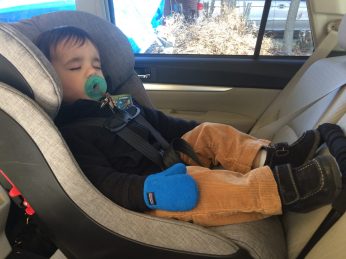PLACEHOLDER Basic info about RFO seats
blah blah blah rear facing only blah
RFO photo
Each car seat has its own minimum and maximum limits so check your car seat’s instruction manual before using the seat.
Typical Minimum Requirements:
Typical Maximum Limits:
When your child has reached ONE of these limits they are too big for the RFO seat and must move into a larger car seat. The vast majority of children will be too tall for their RFO car seat before reaching the seat’s maximum weight limit.
ALWAYS check your car seat’s instruction manual, look at the labels on the seat, or call the car seat’s manufacturer to find out your car seat’s weight and height maximums.
See our rear-facing convertible (toddler) seat recommendations to help you choose the next seat. (Coming Soon!)
Your child doesn’t need to stay in the RFO car seat until they reach the seat’s maximum height/weight. They may move into a rear-facing convertible car seat at any time, as long as they meet that new seat’s minimum age, height, weight and developmental requirements. See our convertible recommendations here.
Reasons to switch to a convertible before your child has met the RFO’s maximum height or weight limit include:
Pro Tip: Keep your infant carrier if your baby still fits in it! You can still use it on vacations, in rental cars, on planes, and if you need portability for another specific situation. It’s always much easier to travel with an infant carrier + stroller than with a convertible car seat.

Nearly 10,000 infants a year in the US suffer a head injury when they fall from or in their car seat when its used out of the car. That’s about equal to the number of babies injured in car crashes! Another study found that from 2004-2008, 31 babies died in their car seats due to asphyxiation (lack of oxygen) or strangulation. Most of these injuries occurred outside of the car and often to older babies–the median age was 9 months.
Jaxon’s mom Meredith wants you to know that Jaxon was a bubbly and precocious child, walking at 10 months and running just weeks after. On October 8th 2015, Jaxon ran some errands with his caregiver and fell asleep in his infant car seat. Not wanting to wake him, the caregiver brought him inside to a quiet room so he could finish his nap. The caregiver left the chest clip buckled, but unbuckled Jaxon’s crotch buckle – a mistake many adults make because they feel bad about leaving a baby buckled, especially while sleeping. Jaxon wiggled in his sleep and as he slipped down his throat got caught on the chest clip – and the more he wiggled, the worse it got. When the caregiver went to check on him, it was too late. He had strangled to death. Had the crotch buckle been buckled, he wouldn’t have been able to slouch down, which is what enabled him to strangle on the chest clip.
Shepard was the healthy baby his mom Ali had longed for after 4 miscarriages. On April 6, 2015, Shepard was in the home of his licensed daycare provider. When it was time for his nap, Shepard was swaddled and placed in his car seat. The straps were left completely unbuckled, presumably because he was “just in the house.” While he was sleeping, Shepard wiggled and slouched and his head fell down into a chin-to-chest position. Because he was so young he couldn’t lift his head up to open up his airway. No one noticed in time, and he asphyxiated to death at just 11 weeks of age. Had he been buckled snug he wouldn’t have been able to slouch down, which is what caused his chin to fall to his chest.
Strangulation:
Asphyxiation:
1. Use the car seat as a car seat. Car seats are NOT strollers, cribs, baby swings, a place to nap at daycare, etc. Use the car seat in the car, and then remove the baby from the seat when you arrive. We know it’s a shame to wake a sleeping baby! If you aren’t going to wake your sleeping baby when you get home, make sure to follow the rules below to minimize risk.
2. Put the car seat in the car, on the stroller, or on the floor. Never put the car seat on a soft surface – like a bed, sofa, or even in the baby’s crib. Car seats can overturn when babies wiggle in them and babies have suffocated when their faces press into the soft surface.
Never put the car seat on a shopping cart, counter top, restaurant high chair, table, sofa, etc. Even though it might seem like a good idea in the moment, car seats get knocked off of these high surfaces all the time, leading to the nearly 10,000 head injuries in babies every year in the US.
3. ALWAYS keep the straps completely buckled AND snug. Do not loosen the straps…even if the baby is just finishing his nap on your living room floor, or you’re just in the stroller, or just anything. Snug straps help babies breathe better by preventing the baby from slumping over and by helping keep the head better positioned. Snug straps make it less likely for the baby’s head to fall into a chin-to-chest position. Loose or unbuckled straps are an asphyxiation risk because the baby’s head can fall into an unsafe position for breathing, as happened to Shepard. Loose or unbuckled straps are also a strangulation risk as the baby can roll over and get his neck caught in the straps.
Do NOT buckle JUST the chest clip – this is a significant risk for strangulation. The crotch buckle is there to prevent your child from slouching down in the seat. Without the crotch buckle, babies have strangled on the chest clip; babies like 9-month-old John Norris, 14-month-old Jaxon Lemerand, 17-month-old Major Maxie, and too many others.
